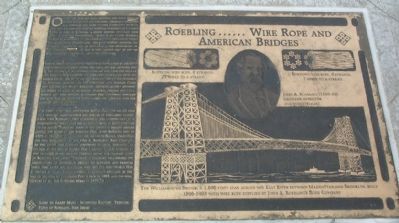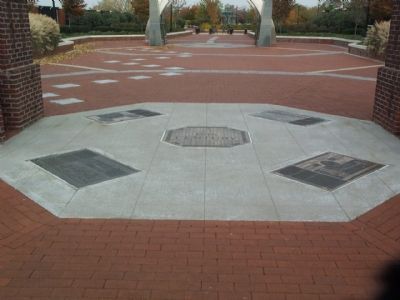South Trenton in Mercer County, New Jersey — The American Northeast (Mid-Atlantic)
Roebling …… Wire Rope and American Bridges
John Roebling relocated to Trenton in 1848, lured by the city’s advantageous location within the canal and rail network, and by the prospect of an abundant supply of wire from the mills of the Trenton Iron Company and easily obtainable coal from the Lehigh Valley. He set up his wire rope factory on the outskirts of Trenton, adjacent to the Delaware and Raritan Canal and Camden and Amboy Railroad. Roebling rapidly expanded his works to meet an increasing national demand foe cable, rigging and wire fencing. A demand that continued through the Civil War Era with the Union’s need for cable and rope for military bridges and ship.
The firm’s long-term reputation rested primarily on its role as a designer, manufacturer and builder of suspension bridges. From John Roebling’s first commission, the construction of a suspension aqueduct over the Allegheny River in 1844 through the mid-20th Century, many of the country’s premier bridges display the stamp of the Roebling firm. John Roebling died in 1869, in the midst of designing the Brooklyn Bridge, whereupon the firm reorganized as the John A. Roebling’s Sons Company. As this entity, the company continued to grow, employing at its peak at the end of World War I around 10,000 workers at five factories in and around Trenton and in the company town of Roebling, New Jersey. Production extended well beyond the manufacture of suspension bridges to elevator and tramcar cable, wire cloth and electrical wire, but the post-World War II decline in heavy manufacturing eventually resulted in the sale of the firm to Colorado Fuel & Iron in 1953, and the final closure of all the Roebling works in 1973-74.
Links to learn more – Invention Factory, Trenton; Town of Roebling, New Jersey
Erected 2004 by New Jersey Department of Transportation.
Topics. This historical marker is listed in these topic lists: Bridges & Viaducts • Industry & Commerce • Railroads & Streetcars. A significant historical year for this entry is 1848.
Location. 40° 11.914′ N, 74° 45.507′ W. Marker is in Trenton, New Jersey, in Mercer County. It is in South Trenton. Marker can be reached from New Jersey Route 29. This marker is part of South River Walk Park which is built over Route 29. Touch for map. Marker is in this post office area: Trenton NJ 08611, United States of America. Touch for directions.
Other nearby markers. At least 8 other markers are within walking distance of this marker. Cooper & Hewitt ….. Iron & Steel (here, next to this marker); Canals and Railroads – Arteries to the Heart of Industrial Trenton (here, next to this marker); From Teacups to Toilets (here, next to this marker); 1750 (here, next to this marker); 1776 (here, next to this marker); 1777 (here, next to this marker); 1784 (here, next to this marker); 1778 (here, next to this marker). Touch for a list and map of all markers in Trenton.
More about this marker. This is one of four subject markers under the 19th Century Arch.
Credits. This page was last revised on February 16, 2023. It was originally submitted on December 19, 2007, by Gary Nigh of Trenton, New Jersey. This page has been viewed 4,054 times since then and 51 times this year. Last updated on February 2, 2021, by Carl Gordon Moore Jr. of North East, Maryland. Photos: 1, 2. submitted on December 19, 2007, by Gary Nigh of Trenton, New Jersey. • Bill Pfingsten was the editor who published this page.

